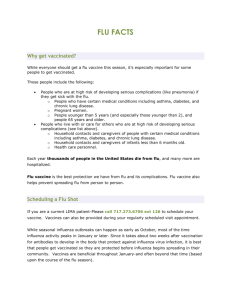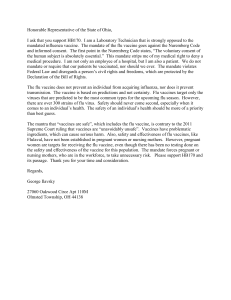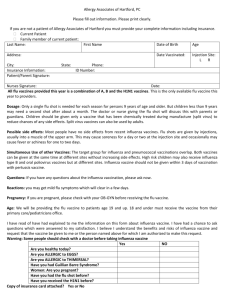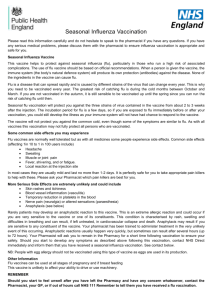Read News from AEFJN No. 35 - October 2009 as Word
advertisement
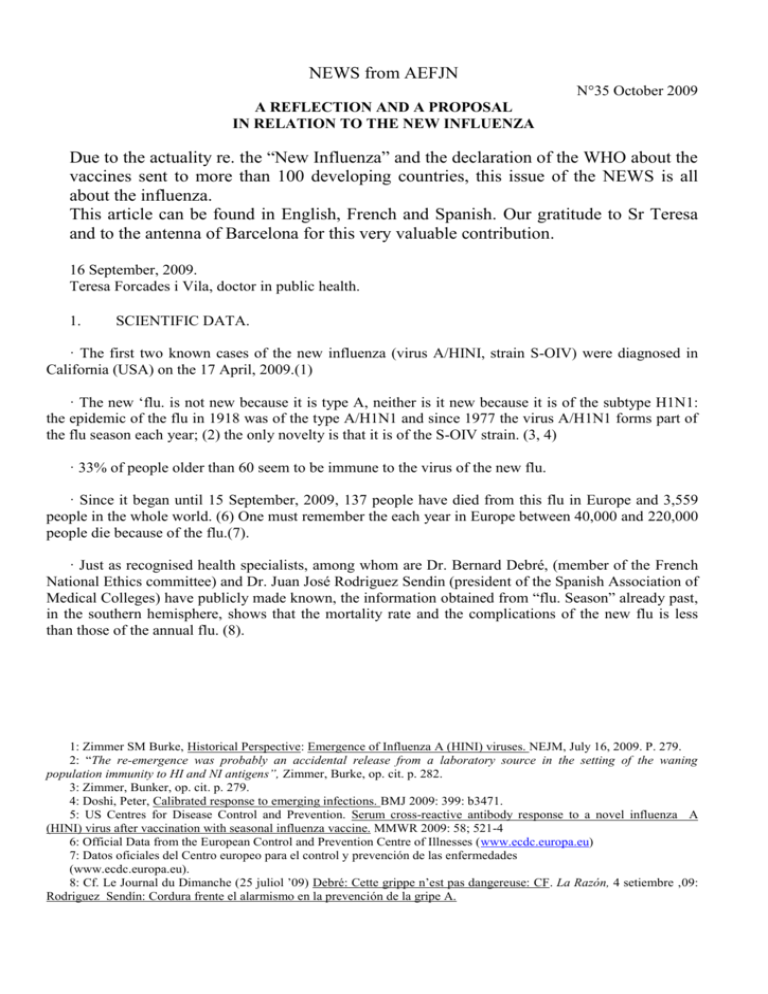
NEWS from AEFJN N°35 October 2009 A REFLECTION AND A PROPOSAL IN RELATION TO THE NEW INFLUENZA Due to the actuality re. the “New Influenza” and the declaration of the WHO about the vaccines sent to more than 100 developing countries, this issue of the NEWS is all about the influenza. This article can be found in English, French and Spanish. Our gratitude to Sr Teresa and to the antenna of Barcelona for this very valuable contribution. 16 September, 2009. Teresa Forcades i Vila, doctor in public health. 1. SCIENTIFIC DATA. · The first two known cases of the new influenza (virus A/HINI, strain S-OIV) were diagnosed in California (USA) on the 17 April, 2009.(1) · The new ‘flu. is not new because it is type A, neither is it new because it is of the subtype H1N1: the epidemic of the flu in 1918 was of the type A/H1N1 and since 1977 the virus A/H1N1 forms part of the flu season each year; (2) the only novelty is that it is of the S-OIV strain. (3, 4) · 33% of people older than 60 seem to be immune to the virus of the new flu. · Since it began until 15 September, 2009, 137 people have died from this flu in Europe and 3,559 people in the whole world. (6) One must remember the each year in Europe between 40,000 and 220,000 people die because of the flu.(7). · Just as recognised health specialists, among whom are Dr. Bernard Debré, (member of the French National Ethics committee) and Dr. Juan José Rodriguez Sendin (president of the Spanish Association of Medical Colleges) have publicly made known, the information obtained from “flu. Season” already past, in the southern hemisphere, shows that the mortality rate and the complications of the new flu is less than those of the annual flu. (8). 1: Zimmer SM Burke, Historical Perspective: Emergence of Influenza A (HINI) viruses. NEJM, July 16, 2009. P. 279. 2: “The re-emergence was probably an accidental release from a laboratory source in the setting of the waning population immunity to HI and NI antigens”, Zimmer, Burke, op. cit. p. 282. 3: Zimmer, Bunker, op. cit. p. 279. 4: Doshi, Peter, Calibrated response to emerging infections. BMJ 2009: 399: b3471. 5: US Centres for Disease Control and Prevention. Serum cross-reactive antibody response to a novel influenza A (HINI) virus after vaccination with seasonal influenza vaccine. MMWR 2009: 58; 521-4 6: Official Data from the European Control and Prevention Centre of Illnesses (www.ecdc.europa.eu) 7: Datos oficiales del Centro europeo para el control y prevención de las enfermedades (www.ecdc.europa.eu). 8: Cf. Le Journal du Dimanche (25 juliol ’09) Debré: Cette grippe n’est pas dangereuse: CF. La Razón, 4 setiembre ‚09: Rodriguez Sendín: Cordura frente el alarmismo en la prevención de la gripe A. 2: IRREGULARITIES WHICH SHOULD BE EXPLAINED: - At the end of January, 2009, the Austrian subsidiary of the North American pharmaceutical company, Baxter, delivered 72 kilos of material to 16 laboratories in Austria, Germany, the Czech Republic and Slovenia. This material was to be used to prepare thousands of vaccines against the seasonal influenza. These vaccines were to have been administered to the population of these countries at least during the months of February and March. Before any of them had been administered, a laboratory technician of the company, BioTest in the Czech Republic decided, on his own, to test the vaccines in ferrets. Ferrets had been used since 1918 to study the influenza vaccines: all the vaccinated ferrets died. Then the material sent by Baxter was investigated to find out what it actually was and it was discovered that it contained live fowl pest (virus) A/H5N1 combined with live virus of each year’s influenza (virus A/H3N2). If this contamination had not been discovered on time, the pandemic, which without a real basis, world sanitary authorities (WHO) and similar national organisations are proclaiming, would now be a horrific reality. This combination of live viruses can be especially lethal because it contains a virus which has a 60% mortality rate but is little contagious (the virus of the avian influenza with another which has a low mortality rate but has a great contagious capacity ( a virus of those of the annual influenza) (9) - On the 29 April, 2009, some 12 days after the detection of the first cases of the new flu., Dr. Margaret Chan, Director General of the WHO, declared that the level of alert because of the danger of pandemic was that of 5 and ordered all governments of the member states of the WHO to activate emergency plans and maximum health alert. A month and a half later, 11 June, 2009, Dr. Chan declared that, world-wide, there was already pandemic (phase 6) because of the virus A/H1N1 S-OIV. (10) How could she declare such a thing in the light of the scientific data expressed above, when the new influenza is, in reality, milder than each year’s flu and also, it is not a new virus and part of the population is immune from it? She could declare it because in the month of May, the WHO had changed its definition of what a pandemic is: before May, 2009, to proclaim a pandemic it was necessary that death was caused by an infectious agent in a significant proportion of the population: this requirement – which is the only thing that gives sense to the clinical notion of pandemic and the political measures which are associated with it – were eliminated from the definition in May, 2009. It was this that permitted, in May, the United States to declare “a national health state of emergency” when only 20 people, in the whole country, had been infected with the new influenza and no one had died. (12) 9: Cf. Virus mix-up by lab could have resulted in pandemic. The Times of India, science section, 6, March 2009. Cf. tb. http://domenys.net/content/view/520/1/ http/www.horizons-et-debats.ch/index.php?id-1739 10: http://www.who.int/mediacentre/news/statements/2009 11: Cohen E. When a pandemic isn’t a pandemic. CNN, 4 May, ’09. http://edition,cnn.com/2009/HEALTH/05/04/swine.flu.pandemic/index.html 12: Doshi, Peter: Calibrated response to emerging infections. BMJ 2009; 339:b3471 3. POLITICAL CONSEQUENCES OF THE DECLARATION OF PANDEMIC · In the context of a pandemic, it is possible to declare the obligatory vaccination of determined groups of people and, indeed, of the whole population. · What can happen to a person who decides not to accept the vaccination? As long as it has not been decreed that the vaccination is obligatory, he is free to do so: but if the vaccination is decreed obligatory then the State has the obligation to enforce the law by imposing a fine or a term in prison (in the state of Massachusetts the proposed fine in this case could be as much as 1,000 dollars for each day that passes until his vaccination) (14) · However, there are those who might think: if the vaccination is made obligatory, I’ll be vaccinated and that’s it. The vaccination is more or less the same as that of the annual flu ,so no problem: it’s not that serious. · It is necessary to know that there are three novelties which make the vaccine for the new flu different from that of the annual one: first novelty: is that the majority of laboratories are designing the vaccination in such a way that one only injection is not enough and that two are necessary: the WHO also recommends that the annual flu vaccination is also administered: whoever follows this recommendation exposes himself to being injected three times. This is something new which, theoretically, multiplies by three the possible secondary effects. In reality, no one knows these effects because, as yet, it has never been done. The second novelty is that some responsible laboratories have decided to put more powerful “additives” than those used until now in the seasonal flu vaccine. These additives are substances which are added to the vaccine to stimulate the immune system: the vaccine of the new flu which Glaxo-Smith-King is manufacturing, for example, has an additive called ASO3 (a combination of “escualeno” and “polisorbato” which multiply by ten the immune response. The problem with this is that no one can be sure that this artificial stimulus to the immune system does not provoke, in time, serious auto immune illnesses ( like the ascending paralysis of Guillain-Barré now) (15). The third novelty which distinguishes the vaccine of the new flu from that of each year is that the manufacturing companies are demanding that the States sign agreements so that they will have impunity if the vaccines have more secondary effects than those fore-seen (ex. It is foreseen that the Guillain-Barré paralysis affects 10 people in every million who are vaccinated): The USA has signed a document which frees not only politicians but also the Pharmaceutical Companies from all responsibility from possible vaccine side effects. (16). 13: Falkiner, Keith. Get the rush flu jab or be jailed: Irish Star, Sunday 13 September, 2009. 14: Senate Bill n. 2028: An act relative to pandemic and disaster preparation and response in the Commonwealth. 4 August, ’09. Cf Moore, RT. Critics rage as state prepares for flu pandemic. 11 Sept. ’09. WBUR Boston. 15: Cf. Vaccination HINI: méfiance des infirmiéres. www.syndicat-infirmier.com/Vaccination-HINI-mefiance-des.htlm 16: Stobbe, Mark. Legal immunity set for swine flu vaccine makers. Associated press 17 July,’09. A REFLECTION: In the despatch of contaminated material, as was sent by Baxter in January, had not been accidentally discovered, the extremely grave pandemic would have been produced with the potential to cause the death of millions of people, which some are announcing. The lack of political and media diffusion of what happened in the month of February in the Czech laboratory is inexplicable. It is even more inexplicable the grade of irresponsibility demonstrated by the WHO, by governments and by the control and prevention of illnesses agencies in declaring a pandemic and promoting a maximum health alert without a real base. It is irresponsible and inexplicable, in the extreme, the billions of Euros, from the public coffers, spent to manufacture millions of doses of vaccines against a non existent pandemic, while there is not sufficient money to help the millions of people (more than 5 million in the US alone) who have lost their job and home. As long as these facts remain unexplained, the risk that contaminated vaccines could be distributed this winter and the risk that legal measures could be adopted to force vaccination are very real. In no case are these risks to be underestimated. If the flu continues to be as mild as it has been up to now, it does not make sense to expose oneself to the risk of a contaminated vaccine nor run the risk of suffering a Guillain-Barré partial paralysis. If the flu gets worse, in an unexpected manner as it did some months ago, and a surprising number of people who are senior officials, among them the General Director of the WHO, announce it without any scientific basis, and even if, suddenly, a higher number of people than normal begin to die because of it, it would still make less sense to allow oneself to be vaccinated for a surprise like that could mean only two things: 1. that the virus of the A strain which is circulating now has suffered a mutation; 2. that another virus or other viruses are now circulating. In both cases, the vaccine that is being currently prepared will be useless, and, considering what happened last February in the Baxter Pharmaceutical Company, it could even be means of transmitting the illness. A PROPOSAL: My proposal is clear: Along with keeping calm, take common sense precautions to avoid contagion and not allow oneself to be vaccinated; this is what many people with common sense in our country are proposing. I make a call to activate urgently the legal instruments and the necessary citizen participation to assure, in a rotund manner, that no one in our country will be forced against his will, to be vaccinated and that those who ask freely to be vaccinated will not be deprived of the right to ask for responsibility and the right to be compensated (they or their family) if the vaccine causes them illness or death.


